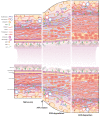Building a Scaffold for Arteriovenous Fistula Maturation: Unravelling the Role of the Extracellular Matrix
- PMID: 37446003
- PMCID: PMC10341877
- DOI: 10.3390/ijms241310825
Building a Scaffold for Arteriovenous Fistula Maturation: Unravelling the Role of the Extracellular Matrix
Abstract
Vascular access is the lifeline for patients receiving haemodialysis as kidney replacement therapy. As a surgically created arteriovenous fistula (AVF) provides a high-flow conduit suitable for cannulation, it remains the vascular access of choice. In order to use an AVF successfully, the luminal diameter and the vessel wall of the venous outflow tract have to increase. This process is referred to as AVF maturation. AVF non-maturation is an important limitation of AVFs that contributes to their poor primary patency rates. To date, there is no clear overview of the overall role of the extracellular matrix (ECM) in AVF maturation. The ECM is essential for vascular functioning, as it provides structural and mechanical strength and communicates with vascular cells to regulate their differentiation and proliferation. Thus, the ECM is involved in multiple processes that regulate AVF maturation, and it is essential to study its anatomy and vascular response to AVF surgery to define therapeutic targets to improve AVF maturation. In this review, we discuss the composition of both the arterial and venous ECM and its incorporation in the three vessel layers: the tunica intima, media, and adventitia. Furthermore, we examine the effect of chronic kidney failure on the vasculature, the timing of ECM remodelling post-AVF surgery, and current ECM interventions to improve AVF maturation. Lastly, the suitability of ECM interventions as a therapeutic target for AVF maturation will be discussed.
Keywords: AVF maturation; arteriovenous fistula; extracellular matrix; vascular remodelling.
Conflict of interest statement
The authors declare no conflict of interest.
Figures



Similar articles
-
Arteriovenous fistula formation with adjuvant endovascular maturation.J Vasc Surg. 2022 Feb;75(2):641-650.e2. doi: 10.1016/j.jvs.2021.08.072. Epub 2021 Sep 8. J Vasc Surg. 2022. PMID: 34506894
-
Relationships Between Clinical Processes and Arteriovenous Fistula Cannulation and Maturation: A Multicenter Prospective Cohort Study.Am J Kidney Dis. 2018 May;71(5):677-689. doi: 10.1053/j.ajkd.2017.10.027. Epub 2018 Feb 2. Am J Kidney Dis. 2018. PMID: 29398178 Free PMC article.
-
Arteriovenous fistula in dialysis patients: Factors implicated in early and late AVF maturation failure.Surgeon. 2016 Oct;14(5):294-300. doi: 10.1016/j.surge.2016.02.001. Epub 2016 Mar 15. Surgeon. 2016. PMID: 26988630 Review.
-
Effect of far infrared therapy on arteriovenous fistula maturation, survival and stenosis in hemodialysis patients, a randomized, controlled clinical trial: the FAITH on fistula trial.BMC Nephrol. 2021 Aug 21;22(1):283. doi: 10.1186/s12882-021-02476-x. BMC Nephrol. 2021. PMID: 34419006 Free PMC article.
-
Role of platelet factor 4 in arteriovenous fistula maturation failure: What do we know so far?J Vasc Access. 2024 Mar;25(2):390-406. doi: 10.1177/11297298221085458. Epub 2022 Jun 24. J Vasc Access. 2024. PMID: 35751379 Free PMC article. Review.
Cited by
-
Interaction between Perivascular and Luminal Factors in Arteriovenous Fistula in Yucatan Miniswine.Cardiol Cardiovasc Med. 2025;9(2):82-88. Epub 2025 Mar 11. Cardiol Cardiovasc Med. 2025. PMID: 40606544 Free PMC article.
-
Increased expression of the P2Y12 receptor is involved in the failure of autogenous arteriovenous fistula caused by stenosis.Ren Fail. 2023;45(2):2278314. doi: 10.1080/0886022X.2023.2278314. Epub 2023 Nov 23. Ren Fail. 2023. PMID: 38532720 Free PMC article.
-
Vascular and Perivascular Role in the Regulation of Angiogenesis: Impact on Arteriovenous Fistula Maturation.Arch Intern Med Res. 2024;7(4):284-296. doi: 10.26502/aimr.0185. Epub 2024 Nov 27. Arch Intern Med Res. 2024. PMID: 39698202 Free PMC article.
-
The Intriguing World of Vascular Remodeling, Angiogenesis, and Arteriogenesis.Int J Mol Sci. 2024 Jun 9;25(12):6376. doi: 10.3390/ijms25126376. Int J Mol Sci. 2024. PMID: 38928082 Free PMC article.
-
Photochemical Modification of the Extracellular Matrix to Alter the Vascular Remodeling Process.J Funct Biomater. 2023 Dec 15;14(12):566. doi: 10.3390/jfb14120566. J Funct Biomater. 2023. PMID: 38132820 Free PMC article.
References
-
- Schmidli J., Widmer M.K., Basile C., de Donato G., Gallieni M., Gibbons C.P., Haage P., Hamilton G., Hedin U., Kamper L., et al. Editor’s Choice—Vascular Access: 2018 Clinical Practice Guidelines of the European Society for Vascular Surgery (ESVS) Eur. J. Vasc. Endovasc. Surg. 2018;55:757–818. doi: 10.1016/j.ejvs.2018.02.001. - DOI - PubMed
-
- Astor B.C., Eustace J.A., Powe N.R., Klag M.J., Fink N.E., Coresh J., Josef Coresh for the CHOICE Study Type of Vascular Access and Survival among Incident Hemodialysis Patients: The Choices for Healthy Outcomes in Caring for ESRD (CHOICE) Study. J. Am. Soc. Nephrol. 2005;16:1449–1455. doi: 10.1681/ASN.2004090748. - DOI - PubMed
-
- Banerjee T., Kim S.J., Astor B., Shafi T., Coresh J., Powe N.R. Vascular Access Type, Inflammatory Markers, and Mortality in Incident Hemodialysis Patients: The Choices for Healthy Outcomes in Caring for End-Stage Renal Disease (CHOICE) Study. Am. J. Kidney Dis. 2014;64:954–961. doi: 10.1053/j.ajkd.2014.07.010. - DOI - PMC - PubMed
Publication types
MeSH terms
LinkOut - more resources
Full Text Sources
Medical
Research Materials

